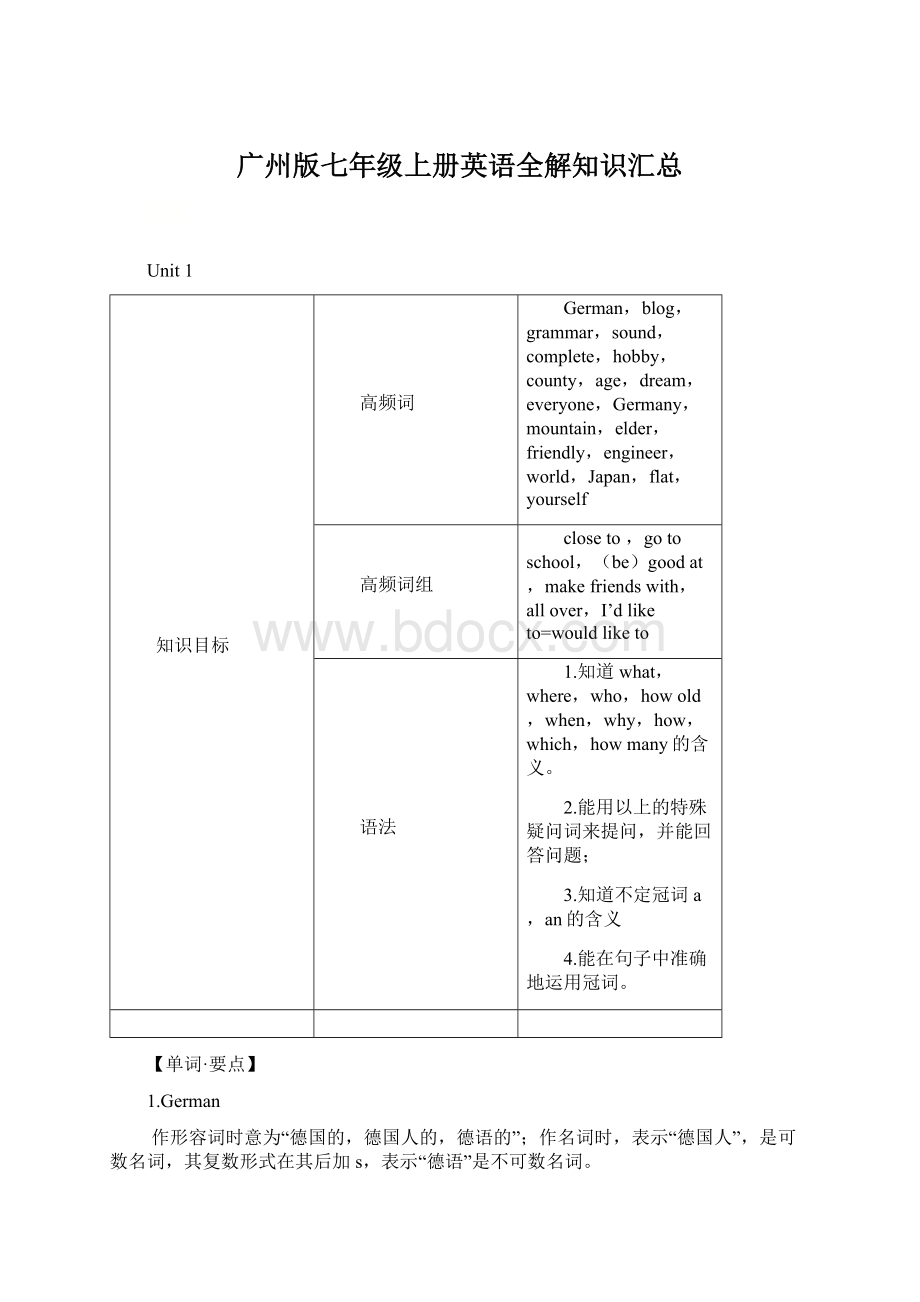 广州版七年级上册英语全解知识汇总文档格式.docx
广州版七年级上册英语全解知识汇总文档格式.docx
- 文档编号:18199147
- 上传时间:2022-12-14
- 格式:DOCX
- 页数:56
- 大小:61.02KB
广州版七年级上册英语全解知识汇总文档格式.docx
《广州版七年级上册英语全解知识汇总文档格式.docx》由会员分享,可在线阅读,更多相关《广州版七年级上册英语全解知识汇总文档格式.docx(56页珍藏版)》请在冰豆网上搜索。

辨析elder与older
elder
用来表示兄弟姐妹及子女之间的长幼关系
常用作定语
都是old的比较级
older
泛指新旧、老幼或年龄的大小关系
可用作表语或定语
e.g.Myelderbrotherisoneyearolderthanme.
6.friendlyadj.友好的。
befriendlytosb.意为“对某人友好”。
friendly虽然以-ly结尾,但它的词性是形容词,而不是副词。
类似的形容词还有:
lovely可爱的lonely孤独的lively生动的
Ugly丑的silly傻的daily每日的
7.manyadj.许多的;
也可作代词,意为“许多”。
e.g.Therearemanystudentsintheschoolyard.在校园里有许多学生。
Manyofusthinkso.我们中有很多人这样认为。
辨析:
many,much与alotof/lotsof
many
修饰可数名词复数
manycarsmanypeople
much
修饰不可数名词
muchwatermuchtime
alotof/lotsof
修饰可数名词复数和不可数名词
alotofcars/water
8.want及物动词,意为“想要”,常见句型结构有:
want+名词
想要.....
Iwantanapple.
want+动词不定式
想要做某事
Iwanttogothere.
wantsb.todosth.
想要某人做某事
Hewantsmetogo.
9.enjoy及物动词,意为”喜欢,享受....”,后常接名词、代词或动名词作宾语。
10.need
①作实义动词时,意为“需要”,有人称、数和时态的变化,其后常接名词、代词或不定式作宾语。
needtodosth.需要做某事。
e.g.Weneedsomewater.
②作情态动词时,意为“需要”,无时态和人称的变化,常用于疑问句和否定句中,其后跟动词原形。
need用于一般疑问句是,肯定回答用must,否定回答用needn’t。
回答以must开头的问句,作否定回答时一般用needn’t。
e.g.Needhesweepthefloornow?
他需要现在扫地吗?
—Yes,hemust./No,heneedn’t.
11.other另外的,其他的。
后接单数或复数名词。
e.g.MyotherhobbiesarewatchingTVandreadingbooks.
辨析other,theother,others,theothers与another
other
泛指“其他的人或物”
可作形容词或代词
e.g.Doyouhaveanyotherquestion?
theother
指两者中的另一个
e.g.Helivesontheothersideoftheriver.
others
指(三者以上)其余的人(物)
作主语、宾语
e.g.Givemesomeothers,please。
theothers
特指某一范围内的“其他的”
作主语
e.g.Twoboyswillgotothezoo,andtheotherswillstays
athome。
Ex.Lilyandhersisterlookthesame.Ican’ttellonefrom.
A.otherB.theothersC.theotherD.others
【短语·
1.playbasketball打篮球。
在英语中,表示进行某种球类运动时,直接用“play+表示球类的单数名词”即可,在球类运动名词前不加任何冠词。
Play后接西洋乐器类名词时,表示“演奏....”,在西洋乐器类名词前必须加定冠词the。
Ex.Billlikesplayingvolleyball,buthedoesn’tlikeplayingpiano.
A.the;
theB./;
theC.the;
/
2.begoodat意为“擅长....”,后接名词、代词或动名词,同义词组为dowellin。
表示“不擅长....”或“在某方面做得不好”,用bebad/poorat.../dobadlyin.../beweakin...。
辨析begoodat,begoodfor与begoodto
begoodat
擅长
Jennyisgoodatdancing.
begoodfor
对....有好处
Vegetablesaregoodforus.
begoodto
对....好
Ourteachersareverygoodtous.
Ex.1)Englishismyfavouritesubject,andIamgoodit.
A.forB.toC.atD.of
2)Amyisgoodat.
A.swimB.swimmingC.swimingD.swims
3.looklike表示“看起来像….”
look是感官动词,后面跟形容词。
look也可以和like搭配,表示“看起来像….”,后面跟名词。
e.g.Youlooksobeautifultoday.
e.g.Thehilllookslikeanelephane.
4.byschoolbus意为“乘校车”
by+表示交通工具的单数名词,构成表示交通方式的介宾短语,意为“乘坐/骑......”。
bybicycle骑自行车bytaxi坐出租车bycar乘小汽车
bybus乘公共汽车bytrain坐火车byplane坐飞机
“by+交通工具名词”在句中作方式状语,提问时用疑问副词how。
5.takethebus意为“乘公共汽车”
辨析take与by
take
动词
都有“搭乘”之意
take后的交通工具前应加限定词
作谓语
by
介词
by后的交通工具前不加限定词
作状语
e.g.Itakethebustoschool.=Igotoschoolbybus.
6.answertothesequestions意为“这些问题的答案”
介词to在此表示归属或附加,意为“归于,属于”。
thekeytothedoor门的钥匙thebridgetotheknowledge通往知识的桥
thewaytoschool去学校的路
7.lotsof=alotof意为“许多的,大量的”。
辨析lotsof/alotof与alot
lotsof/alotof
大量的
常用在名词前作定语,表示数量,
alot
大量,非常
可作主语、表语、宾语或状语,但不能修饰名词。
e.g.Theyneedlotsofmilkeveryday.
MrGreenknowsalotaboutChina.(作宾语)
Monkeyslikeeatingbananasalot.(作状语)
8.hopetodosth.意为“希望做某事”,动词不定时作宾语。
e.g.Ihopetobeyourfriend.
相关结构:
hopefor盼望,期待。
e.g.Wehopeforthebest.
hope+(that)从句...希望...e.g.Ihopethattheywinthematch!
10.hearfrom意为“收到.....的来信”,相当于get/recrivealetterfrom....。
e.g.It’tgreattohearfromyou.
11.aboycalledBruce一名叫布鲁斯的男孩
called是call的过去分词。
过去分词短语calledBruce作后置定语,修饰名词boy。
called在此处相当于named。
【用法集萃】
1.listento听2.closeto接近3.allovertheworld全世界
4.farawayfrom远离5.payattentionto注意6.startwith以....开始
7.ontheInternet8.inEnglish用英语9.learnabout了解
10.tellsb.aboutsth.告诉某人关于某事11.welcometo欢迎光临
12.befrom=comefrom来自13.makefriendswithsb.与某人交朋友
14.like/enjoydoingsth.喜欢做某事15.livein居住在...
16.wouldliketodosth.想做某事17.wouldlikesb.todosth.想某人做某事
Exercises:
1)I’dlikeyouforapicnicwithus.
A.goB.togoC.goingD.went
2)ThestudentsinClassTwolikesports.
A.playingB.palyC.playsD.played
3)Thereapencilandtworulersinthepencil-box.
A.areB.isC.beD.have
4)Lindawantsbasketballwithusthisafternoon.
A.playB.toplayC.playsD.playing
5)DoyouknowthegirlAmy?
A.callB.callsC.calledD.calling
6)WhereyourEnglisteachercomefrom?
A.isB.areC.doD.does
7)It’sveryhardforustoworkouttheanswerthequestion.
A.inB.ofC.onD.to
8)DoyouwanttenniswithmeonSaturdaymorning?
A.toplayB.playC.playing
9)DoyouenjoyEnglishinourclass,MrGreen?
A.teachB.taughtC.toteachD.teaching
10)LisaisalittlepooratChinese.Ithinksheneedsiteveryday.
A.practisetospeakB.topractisespeakingC.practisespeaking
11)Whatdoesyournewschool?
A.likeB.lookC.looklikeD.lookslike
12)Shelooksveryinhernewdress.
A.beautyB.beautifulC.beautifullyD.morebeautiful
13)Hermothergoestoworkbuseverymorning.
A.byB.atC.onD.in
【句子·
1.Mydreamistobeanengineer.我的梦想是成为一名工程师。
本句是一个“主语+连系动词+表语”结构的句子,动词不定式短语在句中作表语。
这类句子的主语通常是dream,work,task等名词。
e.g.Ourworkistocleamtheclassroom.
Yourtaskistogetalltheballsback.
2.Whatdoesyourfather/motherdo?
你父亲/母亲是做什么工作的?
询问某人现在从事何种职业或做什么工作,常用“Whatdo/does+sb.+do?
”句型。
询问职业的其他句型还有:
What+be+sb.?
/Whatissb.’sjob?
/Whatdo/does+sb.+wanttobe?
3.Belowaresomereferencebooks.下面是一些参考书。
本句是一个倒装句。
below作副词,意为“在下面”,与above相对。
e.g.Lookatthepicturesbelow.看下面的图片。
below还可作介词,意为“在.....下方”,可指位置、程度、数量等、
e.g.Theboatisbelowthebridge.船位于桥的下方。
【语法专项】
1、特殊疑问句
1.定义:
特殊疑问句是指以who,what,whose,which,when,where,why,how等疑问句开头,对陈述句中某一部分提问的句子。
回答时,不用yes或no,而是用一个句子或短语。
what
通常用来对职业或事物提问,表示“什么,什么事”
who
通常用来对人提问,表示“谁”
when
通常用来对时间提问,表示“什么时候”
where
通常用来对地点提问,表示“哪里”
which
通常用来对待定范围内的人或物提问,表示“哪一个”
whose
通常用来对所属关系提问,表示“谁的”
why
通常用来对原因提问,表示“为什么”
how
通常用来对方式提问,表示“如何”
howold
通常用来对年龄提问,表示“几岁”
howmany
通常用来对数量提问,表示“多少”,后面跟可数名词的复数形式
howmuch
通常用来对金钱提问,表示“多少钱”
2.句型结构
特殊疑问句的结构为:
疑问词+一般疑问句?
具体有以下两种情况:
(1)疑问词+be+主语(+其他)?
e.g.Whoisyourteacher?
Howoldisyourbrother?
Wherearemybooks?
Whyishelate?
(2)疑问词+助动词+主语+行为动词(+其他)?
e.g.Whatdoesyourfatherdo?
WhydoyoulikeEnglish?
Howmanybooksdoyouhave?
(3)当主语是疑问代词who,whose,what,which或由疑问代词修饰主语时,句子应用陈述语序(主语和谓语不倒装)。
e.g.Wholikesplayingfootbal?
WhichtrainleavesforBeijing?
Exercises:
()1)—doyouspeakEnglishsowell?
—BecauseIpracticeitwithmypartnereveryday.
A.WhyB.WhenC.Who
()2)—isJeremyLin?
—HeisafamousHarvard-educated,Asian-AmericanNBAbasketballplayer.
A.WhereB.WhatC.WhyD.Howold
()3)—doyougotoworkeveryday?
—Bybike.
A.WhatB.WhoC.HowD.When
()4)—canwefindyourbrotheratweekends?
—Onthefootballfield.
A.WhenB.WhichC.WhyD.Where
()5)—isherfavouritesubject?
—Herfavouritesubjectisart.
A.WhyB.WhenC.WhoD.What
二、不定冠词
冠词是一种虚词,放在名词前面,帮助说明名词的含义。
它分为不定冠词(a,an)和定冠词(the)两种。
本单元主要学习不定冠词a和an的用法。
1.a和an的用法
(1)
用于可数名词的单数形式前,指人或事物的某一类
Anelephantisheavy.
(2)
指某人或某物,但不具体说明何人或何物
Areporterwantstoseeyou.
(3)
表示“一”这个数量,但数的概念没有one强烈
Ihaveamouth,anose,twoeyes.
(4)
表示每一,用在表示时间、速度、价格的名词前,相当于every
Igotoschoolfivedaysaweek.
(5)
用于某些固定词组中
alittle,alotof,afew
2.a和an的区别
a用于读音以辅音音素开头的单词前,an用于读音以元音音素开头的单词前。
e.g.anantoradoctoranapple
注:
hour,honest等单词以及f,h,l,m,n,s,x等辅音字母,发音是以元音音素开头的,所以当它们前面需加不定冠词时用an;
相反,useful,university,European等单词的发音却是以辅音音素开头,当它们前面需加不定冠词时用a。
e.g.auniversityanhour
()1)—Excuseme,isthisegg?
—No,it’scake.
A.an;
aB.a;
aC.a;
anD.an;
an
()2)Thereis“u”and“h”intheword“hour”.
anB.a;
aC.an;
aD.a;
()3)—Becareful!
Thereisdoglyingontheground.
—Thanksalot.
A.aB.anC.theD./
Unit2
daily,article,never,tabletennis,ride,usually,so,seldom,guitar,
geography,bell,ring,end,band,practice,together,market,break,grade
juniorhighschool,onfoot,takepartin,haveagoodtime,gotobed,
getup
1.认识一般现在时的基本用法;
2.了解行为动词在第三人称单数后需加“s”或“es”等变化;
3.学会一般现在时的肯定句、疑问句和否定句的句式;
4.在具体情景中能准确地运用频度副词:
always,usually,often,sometimes,seldom,never。
1.love热爱,喜欢
love后面可以接动词的-ing形式和动词不定式,构成句型lovedoingsth.或lovetodosth.,意为“喜欢做某事”。
lovedoingsth强调习惯性的动作,而lovetodosth.强调某一次特定的动作。
可与like互换。
2.so因此,所以
在连接表示原因和结果的两个句子时,so后面的句子表示结果,与前面表示原因的句子往往用逗号分开。
e.g.Iamtired,soIwanttohaveabreak.
3.辨析watch,look,see与read
watch
观看,注视
指全神贯注地看。
看电视、看戏、看比赛、看实验以及各种表演等
watchTV
watchagame/match
look
看,望
指动作的过程,表示有意识地集中精力看,但不一定看见,不强调看的结果,其后接宾语时要加介词at
lookat看lookfor寻找
lookafter照顾
lookup查寻,查阅
see
看见,看到
主要强调动作的结果,但不一定是有意识地看,其后可直接跟名词或代词作宾语
seeamovie看电影
seeadoctor看医生
read
阅读,读懂
主要指看书、看报、看杂志
readnewspaper看报
4.Atabout5:
30pm.大约在下午5:
30
介词at此处表示时间,意为“在”。
辨析at,in与on
at
在具体的钟点前
att
- 配套讲稿:
如PPT文件的首页显示word图标,表示该PPT已包含配套word讲稿。双击word图标可打开word文档。
- 特殊限制:
部分文档作品中含有的国旗、国徽等图片,仅作为作品整体效果示例展示,禁止商用。设计者仅对作品中独创性部分享有著作权。
- 关 键 词:
- 广州 年级 上册 英语 知识 汇总
 冰豆网所有资源均是用户自行上传分享,仅供网友学习交流,未经上传用户书面授权,请勿作他用。
冰豆网所有资源均是用户自行上传分享,仅供网友学习交流,未经上传用户书面授权,请勿作他用。


 如何打造酒店企业文化2刘田江doc.docx
如何打造酒店企业文化2刘田江doc.docx
